Abstract
The toxicity and mutagenicity of three DNA adducts formed by the anticancer drug cis-diamminedichloroplatinum(II) (cis-DDP or cisplatin) were investigated in Escherichia coli. The adducts studied were cis-[Pt(NH3)2(d(GpG))] (G*G*), cis-[Pt(NH3)2(d(ApG))] (A*G*) and cis-[Pt(NH3)2(d(GpTpG))] (G*TG*), which collectively represent approximately 95% of the DNA adducts reported to form when the drug damages DNA. Oligonucleotide 24-mers containing each adduct were positioned at a known site within the viral strand of single stranded M13mp7L2 bacteriophage DNA. Following transfection into E. coli DL7 cells, the genomes containing the G*G*, A*G* and G*TG* adducts had survival levels of 5.2 +/- 1.2, 22 +/- 2.6 and 14 +/- 2.5% respectively, compared to unmodified genomes. Upon SOS induction, the survival of genomes containing the G*G* and A*G* adducts increased to 31 +/- 5.4 and 32 +/- 4.9% respectively. Survival of the genome containing the G*TG* adduct did not increase upon SOS induction. In SOS induced cells, the G*G* and A*G* adducts gave rise predominantly to G-->T and A-->T transversions respectively, targeted to the 5' modified base. In addition, A-->G transitions were detected for the A*G* adduct and low levels of tandem mutations at the 5' modified base as well as the adjacent 5' base were also observed for both adducts. The A*G* adduct was more mutagenic than the G*G* adduct, with a mutation frequency of 6% compared to 1.4% for the latter adduct. No cis-[Pt(NH3)2)2+ intrastrand crosslink-specific mutations were observed for the G*TG* adduct.
Full text
PDF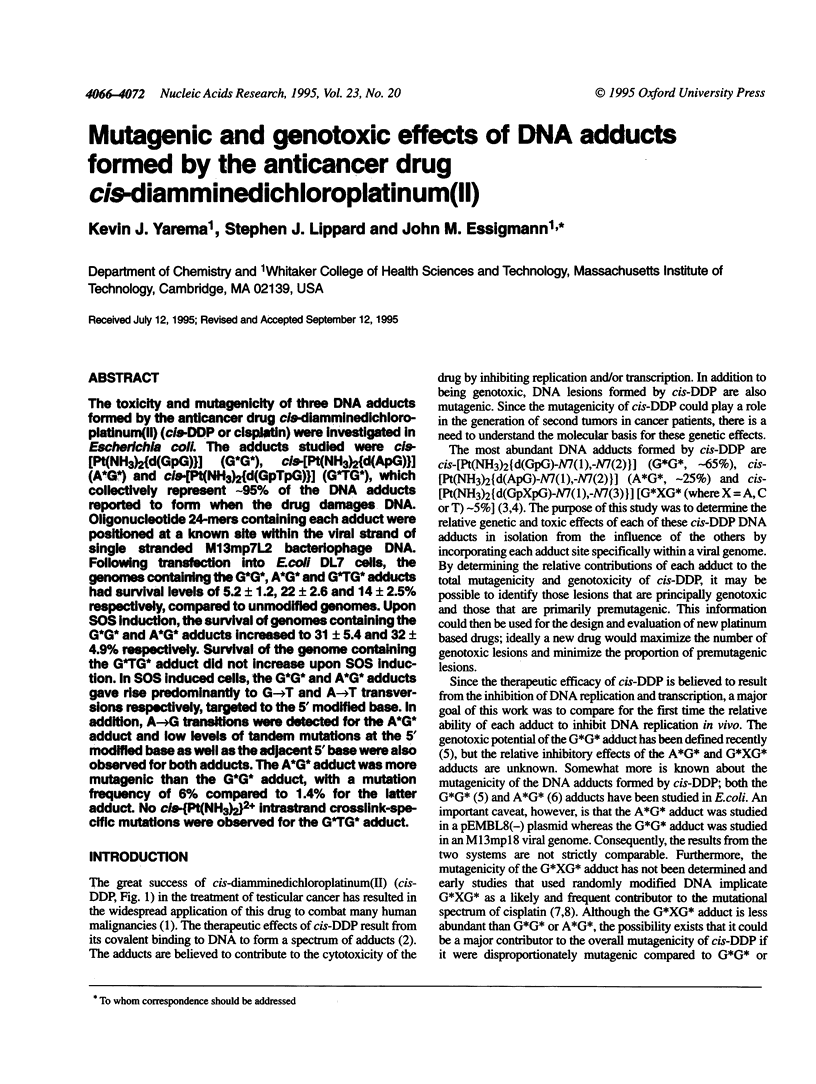
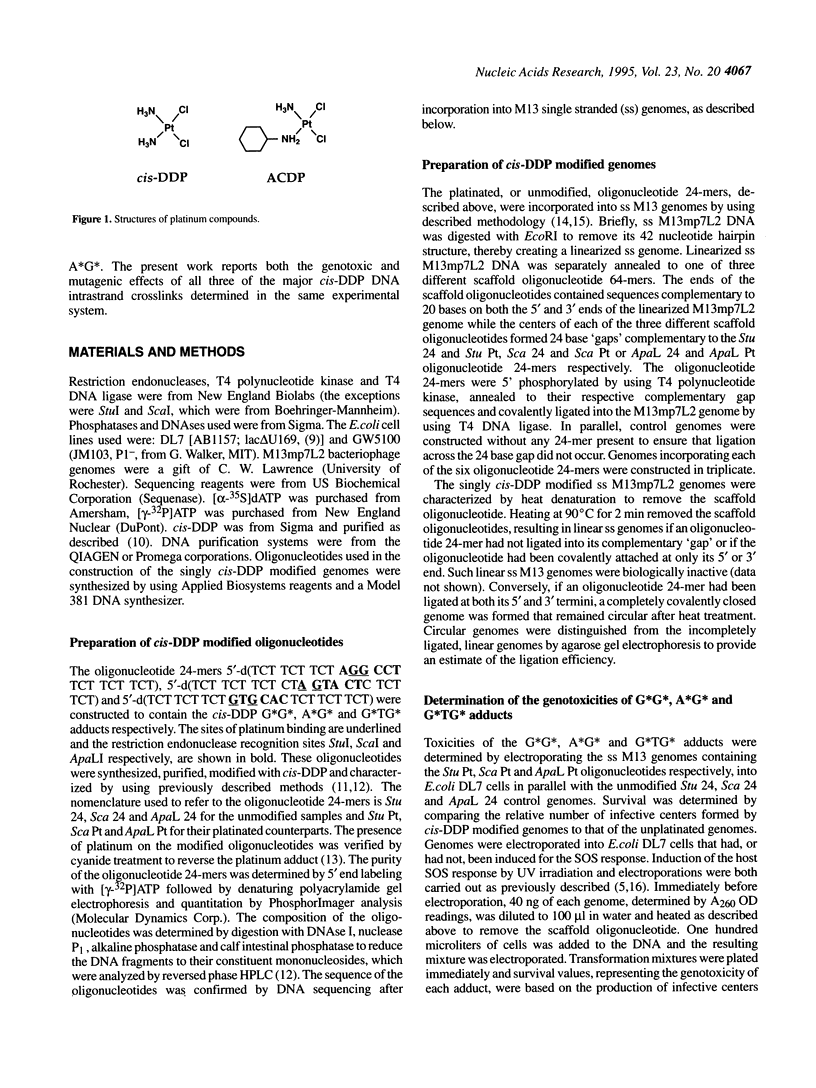
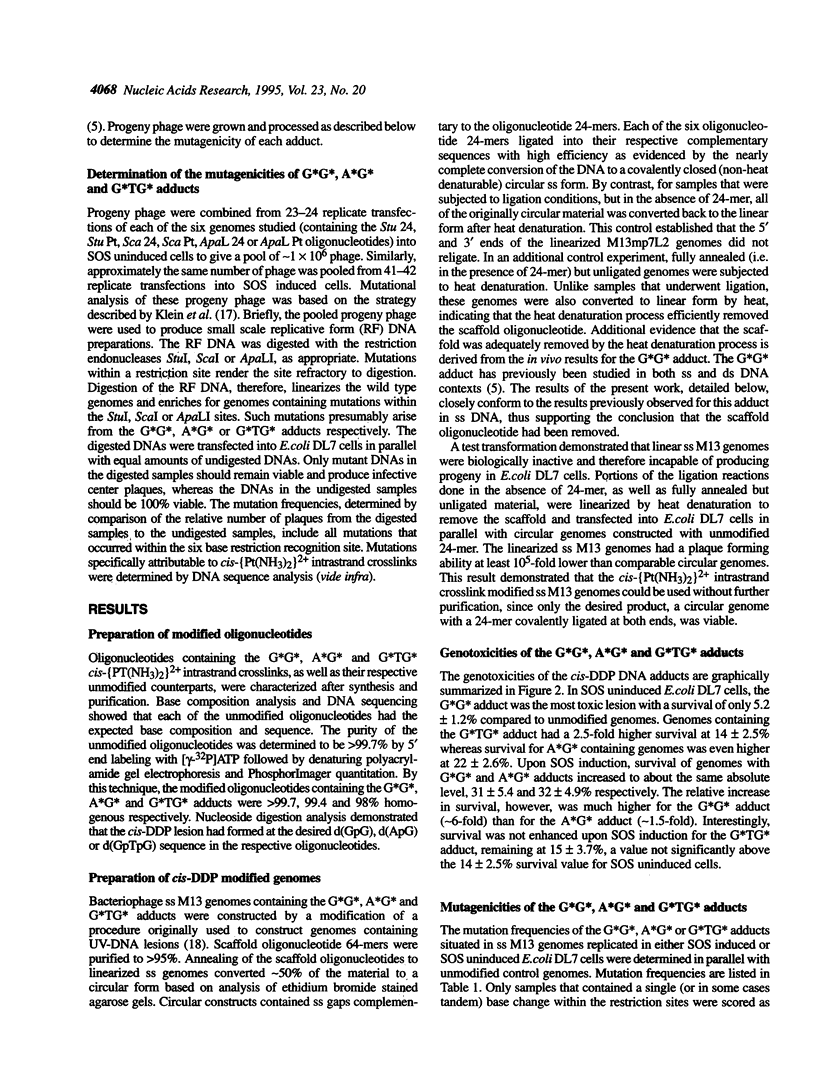
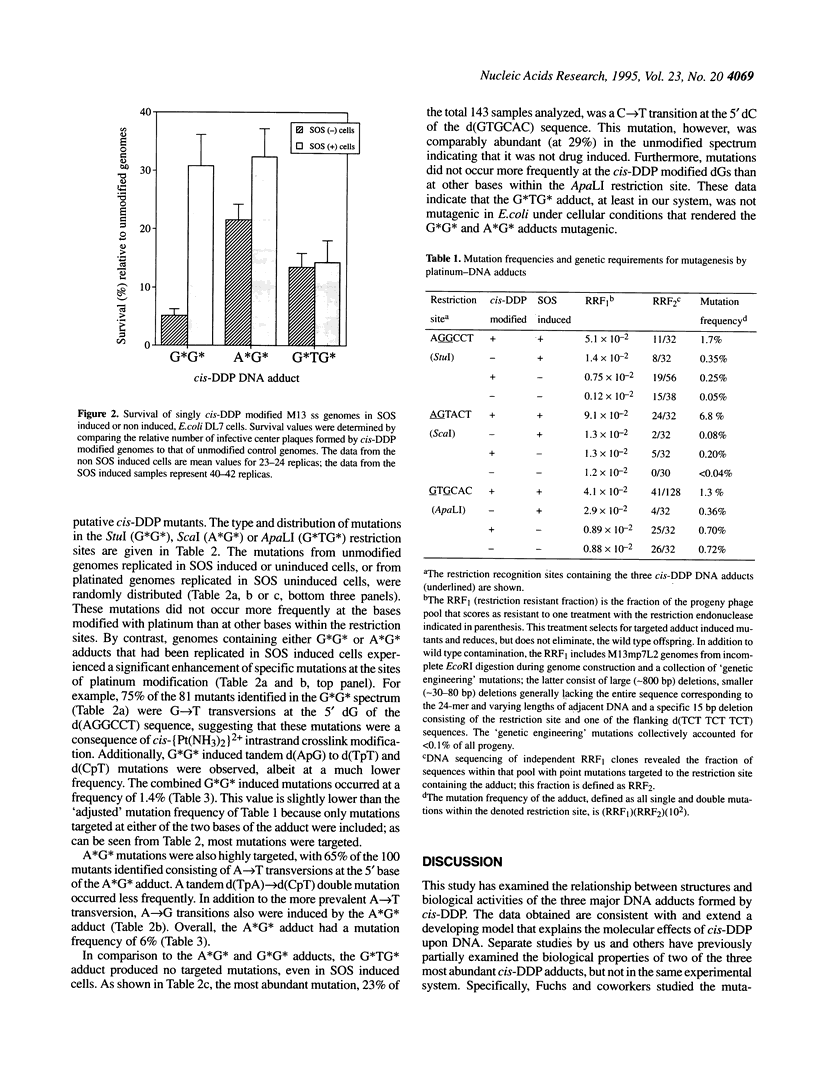
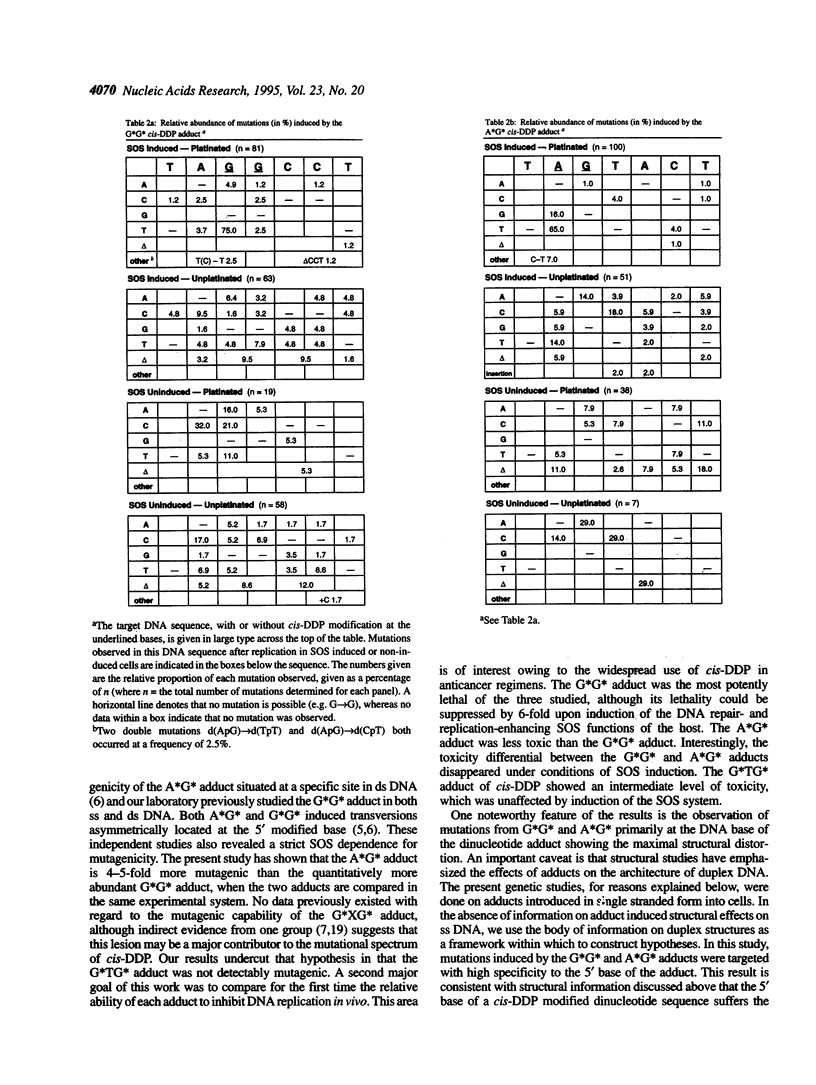

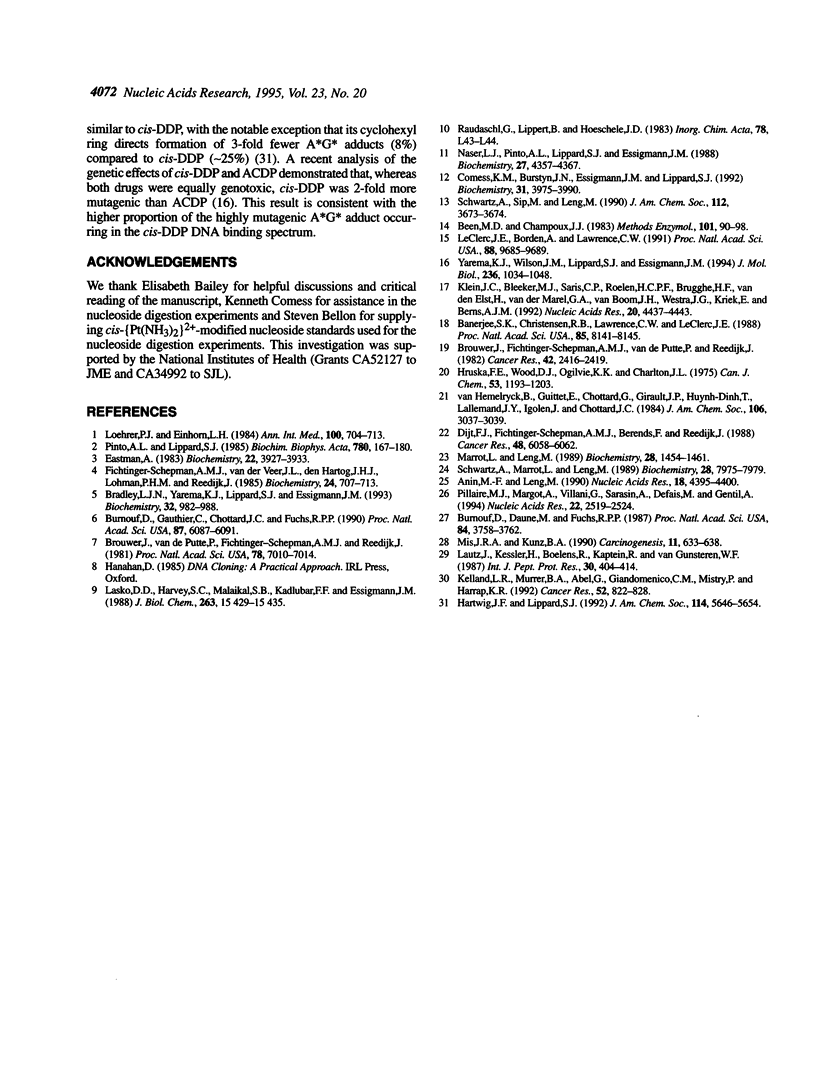
Selected References
These references are in PubMed. This may not be the complete list of references from this article.
- Anin M. F., Leng M. Distortions induced in double-stranded oligonucleotides by the binding of cis- or trans-diammine-dichloroplatinum(II) to the d(GTG) sequence. Nucleic Acids Res. 1990 Aug 11;18(15):4395–4400. doi: 10.1093/nar/18.15.4395. [DOI] [PMC free article] [PubMed] [Google Scholar]
- Banerjee S. K., Christensen R. B., Lawrence C. W., LeClerc J. E. Frequency and spectrum of mutations produced by a single cis-syn thymine-thymine cyclobutane dimer in a single-stranded vector. Proc Natl Acad Sci U S A. 1988 Nov;85(21):8141–8145. doi: 10.1073/pnas.85.21.8141. [DOI] [PMC free article] [PubMed] [Google Scholar]
- Been M. D., Champoux J. J. Cutting of M13mp7 phage DNA and excision of cloned single-stranded sequences by restriction endonucleases. Methods Enzymol. 1983;101:90–98. doi: 10.1016/0076-6879(83)01007-1. [DOI] [PubMed] [Google Scholar]
- Bradley L. J., Yarema K. J., Lippard S. J., Essigmann J. M. Mutagenicity and genotoxicity of the major DNA adduct of the antitumor drug cis-diamminedichloroplatinum(II). Biochemistry. 1993 Jan 26;32(3):982–988. doi: 10.1021/bi00054a031. [DOI] [PubMed] [Google Scholar]
- Brouwer J., Fichtinger-Schepman A. M., van de Putte P., Reedijk J. Influence of temperature on platinum binding to DNA, cell killing, and mutation induction in Escherichia coli K-12 cells treated with cis-diamminedichloroplatinum(II). Cancer Res. 1982 Jun;42(6):2416–2419. [PubMed] [Google Scholar]
- Brouwer J., van de Putte P., Fichtinger-Schepman A. M., Reedijk J. Base-pair substitution hotspots in GAG and GCG nucleotide sequences in Escherichia coli K-12 induced by cis-diamminedichloroplatinum (II). Proc Natl Acad Sci U S A. 1981 Nov;78(11):7010–7014. doi: 10.1073/pnas.78.11.7010. [DOI] [PMC free article] [PubMed] [Google Scholar]
- Burnouf D., Duane M., Fuchs R. P. Spectrum of cisplatin-induced mutations in Escherichia coli. Proc Natl Acad Sci U S A. 1987 Jun;84(11):3758–3762. doi: 10.1073/pnas.84.11.3758. [DOI] [PMC free article] [PubMed] [Google Scholar]
- Burnouf D., Gauthier C., Chottard J. C., Fuchs R. P. Single d(ApG)/cis-diamminedichloroplatinum(II) adduct-induced mutagenesis in Escherichia coli. Proc Natl Acad Sci U S A. 1990 Aug;87(16):6087–6091. doi: 10.1073/pnas.87.16.6087. [DOI] [PMC free article] [PubMed] [Google Scholar]
- Comess K. M., Burstyn J. N., Essigmann J. M., Lippard S. J. Replication inhibition and translesion synthesis on templates containing site-specifically placed cis-diamminedichloroplatinum(II) DNA adducts. Biochemistry. 1992 Apr 28;31(16):3975–3990. doi: 10.1021/bi00131a013. [DOI] [PubMed] [Google Scholar]
- Dijt F. J., Fichtinger-Schepman A. M., Berends F., Reedijk J. Formation and repair of cisplatin-induced adducts to DNA in cultured normal and repair-deficient human fibroblasts. Cancer Res. 1988 Nov 1;48(21):6058–6062. [PubMed] [Google Scholar]
- Eastman A. Characterization of the adducts produced in DNA by cis-diamminedichloroplatinum(II) and cis-dichloro(ethylenediamine)platinum(II). Biochemistry. 1983 Aug 2;22(16):3927–3933. doi: 10.1021/bi00285a031. [DOI] [PubMed] [Google Scholar]
- Fichtinger-Schepman A. M., van der Veer J. L., den Hartog J. H., Lohman P. H., Reedijk J. Adducts of the antitumor drug cis-diamminedichloroplatinum(II) with DNA: formation, identification, and quantitation. Biochemistry. 1985 Jan 29;24(3):707–713. doi: 10.1021/bi00324a025. [DOI] [PubMed] [Google Scholar]
- Kelland L. R., Murrer B. A., Abel G., Giandomenico C. M., Mistry P., Harrap K. R. Ammine/amine platinum(IV) dicarboxylates: a novel class of platinum complex exhibiting selective cytotoxicity to intrinsically cisplatin-resistant human ovarian carcinoma cell lines. Cancer Res. 1992 Feb 15;52(4):822–828. [PubMed] [Google Scholar]
- Klein J. C., Bleeker M. J., Saris C. P., Roelen H. C., Brugghe H. F., van den Elst H., van der Marel G. A., van Boom J. H., Westra J. G., Kriek E. Repair and replication of plasmids with site-specific 8-oxodG and 8-AAFdG residues in normal and repair-deficient human cells. Nucleic Acids Res. 1992 Sep 11;20(17):4437–4443. doi: 10.1093/nar/20.17.4437. [DOI] [PMC free article] [PubMed] [Google Scholar]
- Lautz J., Kessler H., Boelens R., Kaptein R., van Gunsteren W. F. Conformational analysis of a cyclic thymopoietin-analogue by 1H n.m.r. spectroscopy and restrained molecular dynamics simulations. Int J Pept Protein Res. 1987 Sep;30(3):404–414. doi: 10.1111/j.1399-3011.1987.tb03348.x. [DOI] [PubMed] [Google Scholar]
- LeClerc J. E., Borden A., Lawrence C. W. The thymine-thymine pyrimidine-pyrimidone(6-4) ultraviolet light photoproduct is highly mutagenic and specifically induces 3' thymine-to-cytosine transitions in Escherichia coli. Proc Natl Acad Sci U S A. 1991 Nov 1;88(21):9685–9689. doi: 10.1073/pnas.88.21.9685. [DOI] [PMC free article] [PubMed] [Google Scholar]
- Loehrer P. J., Einhorn L. H. Drugs five years later. Cisplatin. Ann Intern Med. 1984 May;100(5):704–713. doi: 10.7326/0003-4819-100-5-704. [DOI] [PubMed] [Google Scholar]
- Marrot L., Leng M. Chemical probes of the conformation of DNA modified by cis-diamminedichloroplatinum(II). Biochemistry. 1989 Feb 21;28(4):1454–1461. doi: 10.1021/bi00430a005. [DOI] [PubMed] [Google Scholar]
- Mis J. R., Kunz B. A. Analysis of mutations induced in the SUP4-o gene of Saccharomyces cerevisiae by cis-diammine dichloroplatinum(II). Carcinogenesis. 1990 Apr;11(4):633–638. doi: 10.1093/carcin/11.4.633. [DOI] [PubMed] [Google Scholar]
- Naser L. J., Pinto A. L., Lippard S. J., Essigmann J. M. Chemical and biological studies of the major DNA adduct of cis-diamminedichloroplatinum(II), cis-[Pt(NH3)2(d(GpG]], built into a specific site in a viral genome. Biochemistry. 1988 Jun 14;27(12):4357–4367. doi: 10.1021/bi00412a024. [DOI] [PubMed] [Google Scholar]
- Pillaire M. J., Margot A., Villani G., Sarasin A., Defais M., Gentil A. Mutagenesis in monkey cells of a vector containing a single d(GPG) cis-diamminedichloroplatinum(II) adduct placed on codon 13 of the human H-ras proto-oncogene. Nucleic Acids Res. 1994 Jul 11;22(13):2519–2524. doi: 10.1093/nar/22.13.2519. [DOI] [PMC free article] [PubMed] [Google Scholar]
- Pinto A. L., Lippard S. J. Binding of the antitumor drug cis-diamminedichloroplatinum(II) (cisplatin) to DNA. Biochim Biophys Acta. 1985;780(3):167–180. doi: 10.1016/0304-419x(85)90001-0. [DOI] [PubMed] [Google Scholar]
- Schwartz A., Marrot L., Leng M. Conformation of DNA modified at a d(GG) or a d(AG) site by the antitumor drug cis-diamminedichloroplatinum(II). Biochemistry. 1989 Oct 3;28(20):7975–7979. doi: 10.1021/bi00446a001. [DOI] [PubMed] [Google Scholar]
- Yarema K. J., Wilson J. M., Lippard S. J., Essigmann J. M. Effects of DNA adduct structure and distribution on the mutagenicity and genotoxicity of two platinum anticancer drugs. J Mol Biol. 1994 Mar 4;236(4):1034–1048. doi: 10.1016/0022-2836(94)90010-8. [DOI] [PubMed] [Google Scholar]


